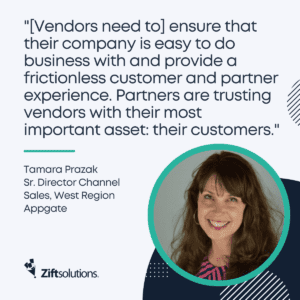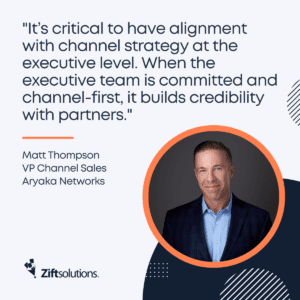- Partner programs need top-down channel commitment on realistic ROI timelines.
- Partner programs need to ensure a frictionless customer experience and partner experience.
- Partner programs need to develop deep partner relationships and stay top of mind.
- Partner programs need to invest in dedicated channel personnel and programs.
- Partner programs need to identify where their partners fit in their partner ecosystem.
- Partner programs need to collaborate with expert partners to penetrate new verticals and industries.
6 Channel Management Best Practices Necessary for Success
Channel programs can often be a gateway to untapped revenue, with channel sales making up 75 percent of global commerce. Partner programs provide key sales benefits to the providers who run them, allowing them to operate a variable salesforce paid exclusively on performance and who are already trusted by businesses of all sizes and verticals.
That sounds like the perfect sales team, right? Experienced professionals with decades of experience successfully selling solutions just like yours to all your target customers without the overhead of salaries and benefits.
The competition for these lucrative partners is fierce and once you’ve recruited and onboarded them, your program will need to manage these partners and guide them to success. What are the top best practices necessary to get the partner engagement right? To answer this question, we spoke with seven industry experts on channel partner management. Our panelists include:
- Su Cook, Partner Development Manager for IT and telecom vendor procurement company Technology Source
- Tamara Prazak, Senior Director of Channel Sales, West Region for secure access provider Appgate
- Matt Thompson, Vice President of Channel Sales for SD-WAN and Unified SASE provider Aryaka Networks
- Brittany Caito, Senior National Partner Manager for cloud communications company Nextiva
- Kelli Ballou-McMillan, Director of Global Partners for cloud contact center provider Five9
- Peter Radizeski, Founder & President for service provider growth strategy consultancy RAD-INFO
- Heather Tenuto, Chief Revenue Officer for partner relationship management (PRM) and channel management platform provider Zift Solutions
Want to skip ahead? Check out six channel management best practices necessary for program success:
- Get Top-Down Channel Commitment on Realistic ROI Timelines
- Ensure a Frictionless Customer Experience (CX) & Partner Experience (PX)
- Develop Deep Partner Relationships & Stay Top of Mind
- Invest in Dedicated Channel Personnel & Programs
- Identify Where Your Partners Fit in Your Partner Ecosystem & Plan Accordingly
- Collaborate with Expert Partners To Penetrate New Verticals & Industries
What is Channel Management?
Channel management refers to a company’s engagement activities related to recruiting, enabling and compensating indirect channel partners.
- What is channel recruitment? Channel recruitment is the process of bringing new companies into a technology vendor’s partner program, which typically includes:
- Wholesale partners
- Resellers
- Value Added Resellers (VARs)
- Managed Services Providers (MSPs)
- Affiliate & Referral Partners
- Distributors
- Independent Retailers
- Agents
- Consultants
- Deployment & Implementation Partners
- Training & Adoption Partners
- Integration Partners
- What is channel enablement? Channel enablement is the process of empowering indirect sales partners to sell and/or promote your products and services. It typically includes training, tools, content, and sales and marketing resources to assist partners with bringing your solutions to market.
- A significant portion of channel enablement is education and training. Even if you’re selling a commoditized product or service, there are several points of differentiation you need to communicate:
- Time to deployment
- Geographical availability
- Applications and benefits
- Standard lengths of sales cycles
- Solution weaknesses, misconceptions and common objections
- Target customer deal size (the goal to close)
- Target customer verticals
- Minimum and maximum deal term lengths
- Annual and month-to-month deal term options
- Support resources available to the end customer
- Promotions available to end customers
- Sales engineering and sales support resources for partners
- A significant portion of channel enablement is education and training. Even if you’re selling a commoditized product or service, there are several points of differentiation you need to communicate:
- Your partners need to know all of the above and be capable of accessing this information at a moment’s notice when the right opportunity for your solution comes their way.
6 Channel Management Best Practices Necessary for Success
How does your company ensure a successful partner program? Our expert panel identified six key channel partner management best practices programs should keep in mind.
1. Get Top-Down Channel Commitment on Realistic ROI Timelines
Companies will start channel programs to aggressively scale growth beyond the limitations of a single direct sales team. Why operate with only one sales team when you could have dozens, hundreds, and thousands of independent sales teams pushing your solutions? Investing in the channel is a no-brainer, but that doesn’t mean your program will instantaneously be a money-printing factory. Program stakeholders and leaders need to manage expectations.
Technology Source’s Cook explains that successful indirect sales programs have grounded executive management and are characterized by a “Senior leadership that is committed to channel partner programs for a respectable timeline that allows for ramping and ROI, depending on the solution, a minimum [of] three years.”
Aryaka Networks’ Thompson agrees, “It’s critical to have alignment with channel strategy at the executive level. When the executive team is committed and channel-first, it builds credibility with partners.”
Cook continues, “If senior leadership isn’t fully committed to channel or affiliate partner programs, it’s because there isn’t a clear understanding of the value of channel partners.”
Cook cautions program leadership on “…not investing enough on experienced channel talent and [expecting] only one or two people to develop the whole program alone. Unless the company is willing to allow those leaders suitable time to ramp up and provide them marketing dollars (networking, etc.) and resources (inside quote team or strong portals), it’s painful and most channel programs are abandoned because the small channel management team is burnt out and recruited away.”
 RAD-INFO’s Radizeski also points to the ROI timeline and financial outlook requiring a long-term view from leadership. “The channel can take up to three years to pay off on the investment. (And there will be a line item on your balance sheet for commissions that may be evergreen which your CFO will hardly like or understand!)
RAD-INFO’s Radizeski also points to the ROI timeline and financial outlook requiring a long-term view from leadership. “The channel can take up to three years to pay off on the investment. (And there will be a line item on your balance sheet for commissions that may be evergreen which your CFO will hardly like or understand!)
Does the vendor have a long-term view and the persistence to see it through? I have seen programs come and go – at very large companies.”
2. Ensure a Frictionless Customer Experience (CX) & Partner Experience (PX)
Appgate’s Prazak reminds programs of the importance of experience. “[Vendors need to] ensure that their company is easy to do business with and provide a frictionless customer and partner experience. Partners are trusting vendors with their most important asset: their customers. If a vendor makes a partner look like a hero to their customer, they’re going to bring that vendor more business.”
Aryaka Networks’ Thompson echoes these sentiments, “Companies also need to align resources to support the partners and their customers. At Aryaka, for example, we have dedicated resources from technical, marketing and CX perspectives to support our partner and customer needs.”
Prazak elaborates further, pointing out that programs need to remove channel conflict, or at the very least control it, “Managing channel conflict is key to building trust, long-term relationships and win/win partnerships.”
Thompson shares a similar warning to programs on channel conflict with both partners and direct teams, “Companies also need alignment with the direct team. In the past, I worked for a company where we were competing with the direct team, which drove conflict internally and doubt with [the] partner community. Partners don’t want to be in the middle of internal conflicts, and it doesn’t give them assurances that they are true partners. Remember, partners have other options and will exercise them. 
3. Develop Deep Partner Relationships & Stay Top of Mind
Communicate, communicate, communicate. As unique as your solutions may (or may not) be, most tech vendors compete in commoditized categories with stiff competition for partner mindshare. You could have a clearly superior product to other market leaders, but if your partners don’t know about it, it won’t be sold.
Aryaka Networks’ Thompson expands on this, “It’s all about relationships with partners, which are built by constantly staying in front of them on a business and personal level. It’s important to understand their businesses, customers and how to help them grow their businesses. Frankly, if we’re not out there doing that, someone else is.”
Thompson argues that channel management is more straightforward than most programs make it out to be. “I think people complicate channel management. It’s about being present, being top of mind. A lot of partners have 50-100 providers. If you’re working in their office or you recently connected with them, they are more likely to come to you with an opportunity and ask, ‘Is this a good fit?’”
Five9’s McMillan agrees that relationships are key, “I believe the most common misconceptions [about managing channel programs] are under-valuing the power of relationships and [that] hiring the wrong team could cost you opportunities to grow and visibility that a new program doesn’t need.”
 Thompson also advises programs to keep their channel sales teams deployed in the field to meet the awareness and relationship-building objectives. “Channel management is less successful when the company gives channel managers too many things to pull them out of the field. Channel managers need to be out there managing relationships with the partners, not getting taken out of the field for non-sales generating activities,” said Thompson.
Thompson also advises programs to keep their channel sales teams deployed in the field to meet the awareness and relationship-building objectives. “Channel management is less successful when the company gives channel managers too many things to pull them out of the field. Channel managers need to be out there managing relationships with the partners, not getting taken out of the field for non-sales generating activities,” said Thompson.
4. Invest in Dedicated Channel Personnel & Programs
Too often, channel programs are treated like the red-headed stepchild of the supplier organization and end up underfunded and understaffed. Your program needs dedicated channel operations, sales and marketing teams to adequately support partners.
Technology Source’s Cook elaborates, “[Programs need] clear process and access to channel resources [such as] marketing, promotions, flyers, case studies, line cards [and] cadences. [Vendors need to provide] access to channel management contacts [and] sales engineers, demos and inside quote teams, a mix of people and [use] technology for scale.”
Nextiva’s Caito says, “Invest in your people; they are the driving force behind channel programs. Invest in operations staff to make sure you have good bones in the program. Invest in sales to make sure your brand is well communicated and represented in the field. Invest in marketing to uphold your standards while creatively attracting new partnerships.”
Traditional direct and channel marketing activities are entirely different disciplines and require their own practitioners, experts and programmatic frameworks.
“The channel should have its own marketing person since marketing to partners is dissimilar to marketing to customers,” says RAD-INFO’s Radizeski.
Channel marketing initiatives can be grouped into three buckets:
- To-channel marketing – To-channel marketing supports the recruitment and engagement of sales partners in a partnership. Partners want to know why they should work with you, the benefits of partnering with your business and how you can help them attract more business. In some instances, to-channel marketing can involve multiple layers, like marketing to both a distributor and its network of resellers.
- Through-channel marketing – Through-channel marketing, sometimes referred to as partner-led marketing, is when your company markets products and services to customers through your sales channels. Through-channel marketing encompasses a range of programs, materials and campaigns that partners can pass on to prospective and current customers. Physical and digital assets typically are set up to be branded or co-branded by the partner.
- For-channel marketing – For-channel marketing is when a supplier markets directly to the customer for the benefit of partners. Some examples of for-channel marketing are:
- A partner locator tool on the vendor’s website that drives leads to the partner.
- Host a special (and often big-budget) event that partners can invite their customers to, such as an exclusive symposium or an entertainment experience.
- A competitive marketing program where the supplier tries to steal market share from a competitor by targeting a list of prospects and connecting them with a partner who can facilitate a try-and-buy offering. The partner is a trusted, unbiased advisor to the customer and the vendor drives the competitive message.
Nextiva’s Caito adds, “Lean on your channel marketing teams. I have seen really strong marketing programs that can creatively drive revenue to the business. Task them with lead-generating and pipeline programs. Nextiva has some targeted partner marketing programs that promote growth for partners and help build their business.”
 5. Identify Where Your Partners Fit in Your Partner Ecosystem & Plan Accordingly
5. Identify Where Your Partners Fit in Your Partner Ecosystem & Plan Accordingly
Vendors need to define the roles, responsibilities and trading practices for the members of their ecosystem. Once your program establishes clear roles in your partner ecosystem, you’ll be able to develop a plan to fill out the entire ecosystem model and manage partners of all types.
“If you are new to the industry, work closely with the leaders in your preferred routes to market to understand how they differentiate themselves, what makes their partners unique and what their partners are solving for with their customers,” advised Five9’s McMillan.
“Furthermore, understand how you as a vendor will contribute to this ecosystem and learn from the mistakes [of] those vendors with similar technologies that came before you.”
Aryaka Networks’ Thompson also sees the ecosystem model as a new challenge to tackle for programs, both new and old. “The types of partners have expanded to cover every phase of the customer journey; awareness, evaluation, selection, deployment, adoption, upgrade/expansion [and] renewal. There could be a consultant influencing the deal that you don’t even know about. Trying to support all of these partner types and creating a model that satisfies all their requirements is challenging.”
6. Collaborate with Expert Partners to Penetrate New Verticals & Industries
Our expert panel believes that successfully managed channel programs educate their partners on where their solutions are the best fit and provide highly-targeted messaging.
Nextiva’s Caito explains, “I’ve seen successful channel management when you have specialty and resident experts on staff. Our industry does a significant amount of work in verticals [and] it pays to have those experts aligned with partners in the field. [For example] having a hospitality-specific resource available to partners can go a long way.”
“Identify your experts,” continues Nextiva’s Caito. “You likely have people in place that hold expertise in certain verticals; evangelize that! And if you don’t, set aside budget to hire talented, vertical-specific people [for] your company. Don’t be scared to hire someone directly from manufacturing or financial verticals. They can speak the lingo and connect the dots.”
Five9’s McMillan cautions against not making customer targets clear for partners, “An unsuccessful program is one that isn’t cohesive in their messaging around technology or their go-to-market strategy for their partners. When partners can’t easily identify customer verticals, they are less likely to lead with your services. The more friction, the [fewer] opportunities.” 
Our panel also believes that programs need to focus on recruiting and collaborating with partners that have their own niche expertise to help them penetrate new markets.
“Assuming they don’t offer a single highly-specific product, it’s unrealistic for vendors to be true experts in every industry or vertical their solutions are a fit for,” says Zift Solutions’ Tenuto. “A varied partner ecosystem means that suppliers can lean on their partners who have niche expertise to help sell, evangelize, deploy or even engineer new use cases for markets they normally wouldn’t be able to serve.”
Working with these newfound ecosystem partners can lead to new co-marketing and co-selling messaging, collateral and campaigns to generate leads. Plus, once you’ve cracked the code on one vertical, you can repurpose those same materials for use with other partners in new campaigns. Zift Solutions’ Tenuto continues, “Developing comprehensive go-to-market campaigns for new markets can be intimidating for some partners. Fortunately, you won’t have to reinvent the wheel every time a new lead gen program is proposed. You can end up with a library of go-to assets for a given industry and become faster at deploying each new campaign.”
Appgate’s Prazak also points to successful programs providing new verticals and market opportunities, “Successful channel management results in increased lead flow, access to new markets and verticals, more closed deals and your sales team wanting to bring partners into engagements.“
New and mature channel companies can use the above best practices to optimize the management of their partner programs and boost ROI.


 5. Identify Where Your Partners Fit in Your Partner Ecosystem & Plan Accordingly
5. Identify Where Your Partners Fit in Your Partner Ecosystem & Plan Accordingly


